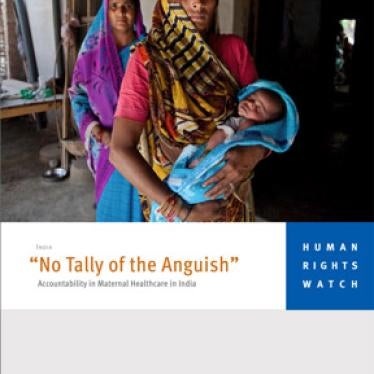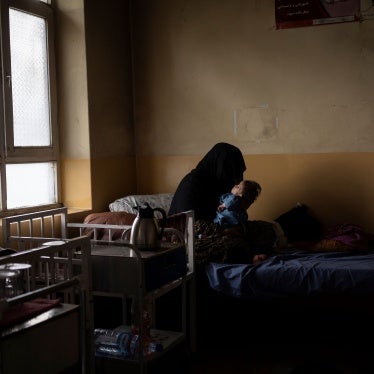(New York) - New United Nations global maternal mortality estimates contradict the Indian government's claim that it is "on track" to meeting UN goals for reducing maternal mortality, Human Rights Watch said today.
An assessment by the World Health Organization and other UN agencies found that even though India is "making progress" in declining maternal mortality, it is not "on track" to meeting its goal under the UN Millennium Development Goals. The 2008 figures, the latest global estimates, were released in advance of the UN Summit on Millennium Development Goals, scheduled to commence September 20, 2010, at the UN.
The UN agencies also found that maternal deaths in India along with countries like Afghanistan, Bangladesh, the Democratic Republic of Congo, Ethiopia, Indonesia, Kenya, Nigeria, Pakistan, Sudan, and Tanzania together accounted for 65 percent of all global maternal deaths in 2008.
In May, the Indian government contested the report of the UN special rapporteur on health and disputed his contention that India would fail to meet its UN goal for reducing maternal mortality.
"Going by the rate of decline in the past and comprehensive efforts being made across the country, it appears that India is on the right track with regard to MDG-5," the government said at that time.
"The Indian government should stop playing number games with women's lives," said Aruna Kashyap, Asia women's rights researcher at Human Rights Watch. "The Indian government is dangerously misleading the public, and itself, about the nature of progress on maternal health."
The Indian government continues to wrongly focus on the number of women who give birth in a health facility, known as institutional deliveries, as a measure of progress on maternal health. But this approach gives an erroneous picture about progress on maternal health, Human Rights Watch said.
The Indian government stated that maternal health in the country had considerably improved because 10 million women had given birth in health facilities in 2009 and into 2010. Under its flagship National Rural Health Mission and Janani Suraksha Yojana (JSY), or safe motherhood scheme, the Indian government uses cash incentives to encourage women to give birth in health facilities. The government does not, however, measure the numbers of women who survive the delivery and the post delivery period, a much more accurate measure of success.
Even as India proudly proclaims its progress on maternal health, for many women the tragedy of maternal mortality and morbidity continues. Repeated health system failures - poor transport, referral mechanisms, emergency obstetric care, and continued care in the post partum period -hamper delivery of care to pregnant women, Human Rights Watch said.
The death of a woman in the streets of New Delhi, the capital, in July, is a case in point, Human Rights Watch said. News reports said that she had given birth unattended on the pavement, lay there with no assistance for four days in dirty rain water and then died.
In a report released in October 2009, Human Rights Watch detailed why using the number of institutional deliveries as a measure of progress on maternal health is misleading:
- Inflated figures: Many women told Human Rights Watch that health workers were asking them to say they delivered in a health facility to receive the cash incentive, promising to split the money. In reality the women had delivered at home.
- No count of deaths en route to a health facility: Due to poor access to emergency transport, many women died on their way to a health facility. This is not reflected in the figures, and little has been done to improve emergency transportation.
- Numbers camouflage barriers in accessing health facilities as well as the quality of facility-based care: Most hospitals that Human Rights Watch visited were only able to conduct normal deliveries. Even health facilities designated comprehensive emergency obstetric care centers did not have emergency obstetric facilities. Women were routinely referred from one hospital to another, until they eventually reached a far-flung medical college hospital for care, assuming they were able to reach such a hospital in time. Further, many poor women had to spend considerable amounts of money to reach a health facility and secure care. The number of institutional deliveries hides these long-standing barriers to timely and adequate care.
Even facilities Human Rights Watch visited that were able to handle normal deliveries were often not prepared for the volume of cases they had to handle. Doctors reported that women were giving birth on floors or even in corridors. In post-delivery recovery wards, many mothers and their newborns were sharing beds with other women, risking catching infections from each other.
Most women were discharged within 24 hours of their delivery, and few stayed as long as two or three days.
- Poor information on pregnancy outcome: Even where women gave birth in health care facilities, health officials had no information on whether they survived through the postpartum period. Human Rights Watch traced several cases in which women had given birth in a health facility but had developed complications after discharge and eventually died at home or en route a health facility.
- Questions about safe delivery: Merely delivering in a health facility does not automatically lead to safe delivery. The right equipment, emergency drugs, training, cleanliness, and non-abusive treatment are needed to create safe conditions for the pregnant woman and her baby. These conditions are yet to be fully satisfied in many hospitals Human Rights Watch visited.
"Sending women around begging at the gates of different hospitals for an ‘institutional delivery' is questionable ‘progress,'" Kashyap said. "What good are token improvements if the path to ‘institutional delivery' is an altered obstacle course with no quality guarantees?"
In its 2009 report, the United Nations Population Fund (UNFPA) assessed the functioning of the Indian safe motherhood program in five states and concluded that it should not focus on promoting institutional deliveries alone. The report noted that "[i]n the absence of corresponding inputs for human resources, additional labor rooms and postnatal beds, drugs and other supplies, quality of services, etc. have been a major casualty," in institutional deliveries.
UNFPA recommended that monitoring the quality of facilities should become an "integral component" of the safe motherhood program and suggested that it carry out this change so that "service providers and program managers also appreciate the importance of the focus in the quality of services provided and don't see their role only as mere distributors of money."
"Accountability in maternal health care requires the Indian government to use the right indicators to measure progress and to make the needed changes," Kashyap said. "The problem with a focus on institutional deliveries is that the Indian government is deliberately turning a blind eye to other important indicators and problems."
The Indian government started a maternal death investigation program this year, and Human Rights Watch said that this can be a step in the right direction if the investigations are carried out thoroughly.
In addition to conducting maternal death investigations, the Indian government should immediately take the following steps, Human Rights Watch said:
- Change its measure of progress from number of institutional deliveries to number of safe deliveries.
- Monitor the quality of care under the safe motherhood program by conducting periodic "quality audits."
- Conduct periodic "referral audits" to verify the quality of and identify problems with its referral systems even in places where institutional deliveries are increasing.
- Conduct periodic "emergency obstetric care" audits to determine whether the safe motherhood program is successfully providing emergency obstetric care in health facilities designated to provide such care.







